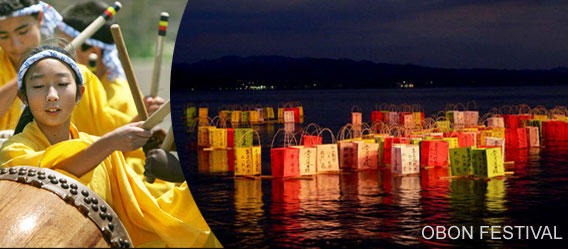
Obon festival, also sometimes known as Bon festival in Japan, is a time of celebration and family reunion as the people of Japan commemorate their ancestors. It is one of three major holiday seasons in Japan. Obon is a Buddhist festival, and during the festival, people return to their ancestral family homes to visit and clean the graves of ancestors. Much akin to the Chinese "Qing Ming" festival where the graves of deceased family members and ancestors are visited, the Obon festival is a time to honor the deceased and to celebrate familial bonds.
The Obon festival was traditionally celebrated on the fifteenth day of the seventh month of the lunar calendar, but when the lunar calendar was substituted by the Gregorian calendar during the Meiji era, the celebration of the Obon festival became varied according to regions.Today, Obon festival is celebrated on the 15th of July in the Eastern regions of Japan in Tokyo, Yokohoma, and the Tohoku region). Other regions in Japan celebrate Obon either on the 15th of August, or follow the tradition of following the lunar calendar whereupon, the Obon festival would fall on a different day ever year as according to the lunar calendar.
Celebrating Obon festival
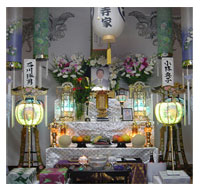 The Obon festival lasts for three days. During the three days of the festival, Japanese people pay respect by visiting their ancestors' graves. In preparation for the festival, homes are cleaned and flower arrangements are made. Lanterns known as bon chochin lanterns are also lit and are placed along with fruits and vegetable food offerings at a butsudan-a Buddhist altar. The prepared offerings, flower arrangements and chochin lanterns are then placed at the altar.
The Obon festival lasts for three days. During the three days of the festival, Japanese people pay respect by visiting their ancestors' graves. In preparation for the festival, homes are cleaned and flower arrangements are made. Lanterns known as bon chochin lanterns are also lit and are placed along with fruits and vegetable food offerings at a butsudan-a Buddhist altar. The prepared offerings, flower arrangements and chochin lanterns are then placed at the altar.
On the first day of the Obon festival, family members will light the chochin lanterns-paper lanterns that are often placed at the butsudan-a Buddhist altar. Family members will then visit the grave of ancestors to call their spirits home.
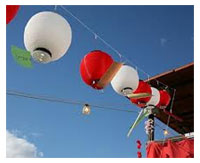 In some regions of Japan, mukae-bis are lit outside the entrances of homes to help guide ancestral spirits home. In Kyoto, giant bonfires are also lit during the height of the Obon festival creating a climatic moment of the festival as bonfires are lit up forming giant characters that can be viewed from a distance. Known as the Gozan no Okuribi, or more commonly known as Daimon-ji that can be translated literally as "Giant Words", majestic words are lit up on the mountains surrounding Kyoto in celebration of the Obon festival. During the Gozan no Okubiri, five bonfires are lit forming the words: Great wondrous Dharma, followed by an image of a boat. The character for great is then repeated followed by the shape of a shrine gate.
In some regions of Japan, mukae-bis are lit outside the entrances of homes to help guide ancestral spirits home. In Kyoto, giant bonfires are also lit during the height of the Obon festival creating a climatic moment of the festival as bonfires are lit up forming giant characters that can be viewed from a distance. Known as the Gozan no Okuribi, or more commonly known as Daimon-ji that can be translated literally as "Giant Words", majestic words are lit up on the mountains surrounding Kyoto in celebration of the Obon festival. During the Gozan no Okubiri, five bonfires are lit forming the words: Great wondrous Dharma, followed by an image of a boat. The character for great is then repeated followed by the shape of a shrine gate.
Gozan no Okuribi begins at eight in the evening. Words are lit up at five to ten minute intervals and thousands gather every year to witness the lighting of the bonfire.
On the last day of the festival, the spirits of the ancestors are returned to the grave. On the third day, chochin lanterns bearing the crest of the family are hung are a way to guide the spirits back to their graves. Known as Okuri-bon, these chochin lanterns can be seen hanging on the final day of the festival. In some regions, fires known as okuri-bis are lit at the entrances of houses to send off the spirits.
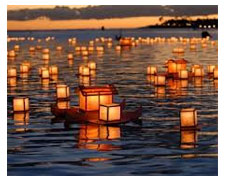 Floating lanterns known as Toro Nagashi are also common sights during the festival, as many send off the spirits of their ancestors with lit lanterns that float down river to the ocean.
Floating lanterns known as Toro Nagashi are also common sights during the festival, as many send off the spirits of their ancestors with lit lanterns that float down river to the ocean.
Although the Obon festival is a time to honor the dead, it is by no means a solemn festival. It is also a joyful celebration of family reunion.During this time, fairs are also often held where games are played. A traditional folk dance known as Bon Odori is also performed during this time. It is a dance that welcomes the spirits of the dead and a wide variety of the dance exists from region to region.
Commonly, people gather at a local shrine, park, garden or temple where the Bon Odori is held. Wearing the yukata-a kimono for summer, people dance to the beat of Japanese Taiko drums and to folk songs known as min'yo, although like the dance, the music can also vary drastically from region to region.
History of Obon festival
The origin of the Obon festival is a moving story of filial piety. According to traditional belief, the word Obon is a shortened form of the word Ullambana-a Sanskrit word that means hanging upside down and denotes pain and great suffering.
 The story goes that Maha Maudgalyayana (Mokuren), a disciple of the Buddha had a vision of his deceased mother. In his vision, she had fallen into the realm of Hungry Ghost and was suffering. Mokuren then asked the Buddha what he could do to help his mother and release her from her suffering. The Buddha told Mokuren that he could make offering to Buddhist monks who had completed their summer retreat on the fifteenth day of the seventh month. Mokuren did as he was told and his mother was released. It was also said that as a result of his mother's release, and the realization of his mother's past unselfish acts of kindness to him, Mokuren began to dance with joy. It was this dance that later became Bon oduri-the festive dance practiced every year during the Obon festival.
The story goes that Maha Maudgalyayana (Mokuren), a disciple of the Buddha had a vision of his deceased mother. In his vision, she had fallen into the realm of Hungry Ghost and was suffering. Mokuren then asked the Buddha what he could do to help his mother and release her from her suffering. The Buddha told Mokuren that he could make offering to Buddhist monks who had completed their summer retreat on the fifteenth day of the seventh month. Mokuren did as he was told and his mother was released. It was also said that as a result of his mother's release, and the realization of his mother's past unselfish acts of kindness to him, Mokuren began to dance with joy. It was this dance that later became Bon oduri-the festive dance practiced every year during the Obon festival.
A time of reunion
Like the celebration of Thanksgiving in Northern America, Obon festival is also a time of family reunion. Many Japanese take vacation during what is known as the Obon week to return home to be reunited with family members during a festival that was born out of a Mokuren's love for his mother.
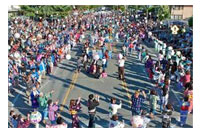 During the Obon festival, people attend fair where they join in fun and games of the event with fun rides, delicious seasonal food and fruits that finally culminate in display of floating lanterns and fireworks. It is a time of joy as much as it is a time to reflect upon the deceased. Like the el Día de los Muertos celebrated in Mexico, the Obon festival is a remembrance of the dead as much as it is a celebration of living.
During the Obon festival, people attend fair where they join in fun and games of the event with fun rides, delicious seasonal food and fruits that finally culminate in display of floating lanterns and fireworks. It is a time of joy as much as it is a time to reflect upon the deceased. Like the el Día de los Muertos celebrated in Mexico, the Obon festival is a remembrance of the dead as much as it is a celebration of living.
If you like the Obon festival, you may also like our bookmark set featuring six of Kyoto's traditional festivals, including the Gozan no Okuribi. |


 The Obon festival lasts for three days. During the three days of the festival, Japanese people pay respect by visiting their ancestors' graves. In preparation for the festival, homes are cleaned and flower arrangements are made.
The Obon festival lasts for three days. During the three days of the festival, Japanese people pay respect by visiting their ancestors' graves. In preparation for the festival, homes are cleaned and flower arrangements are made.  In some regions of Japan, mukae-bis are lit outside the entrances of homes to help guide ancestral spirits home. In Kyoto, giant bonfires are also lit during the height of the Obon festival creating a climatic moment of the festival as bonfires are lit up forming giant characters that can be viewed from a distance. Known as the Gozan no Okuribi, or more commonly known as Daimon-ji that can be translated literally as "Giant Words", majestic words are lit up on the mountains surrounding Kyoto in celebration of the Obon festival. During the Gozan no Okubiri, five bonfires are lit forming the words: Great wondrous Dharma, followed by an image of a boat. The character for great is then repeated followed by the shape of a shrine gate.
In some regions of Japan, mukae-bis are lit outside the entrances of homes to help guide ancestral spirits home. In Kyoto, giant bonfires are also lit during the height of the Obon festival creating a climatic moment of the festival as bonfires are lit up forming giant characters that can be viewed from a distance. Known as the Gozan no Okuribi, or more commonly known as Daimon-ji that can be translated literally as "Giant Words", majestic words are lit up on the mountains surrounding Kyoto in celebration of the Obon festival. During the Gozan no Okubiri, five bonfires are lit forming the words: Great wondrous Dharma, followed by an image of a boat. The character for great is then repeated followed by the shape of a shrine gate.  Floating lanterns known as Toro Nagashi are also common sights during the festival, as many send off the spirits of their ancestors with lit lanterns that float down river to the ocean.
Floating lanterns known as Toro Nagashi are also common sights during the festival, as many send off the spirits of their ancestors with lit lanterns that float down river to the ocean.  The story goes that
The story goes that  During the Obon festival, people attend fair where they join in fun and games of the event with fun rides, delicious seasonal food and fruits that finally culminate in display of floating lanterns and fireworks. It is a time of joy as much as it is a time to reflect upon the deceased. Like the
During the Obon festival, people attend fair where they join in fun and games of the event with fun rides, delicious seasonal food and fruits that finally culminate in display of floating lanterns and fireworks. It is a time of joy as much as it is a time to reflect upon the deceased. Like the 